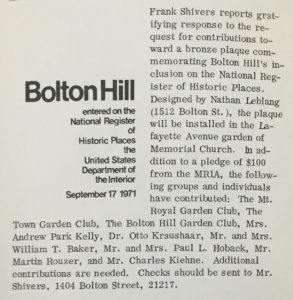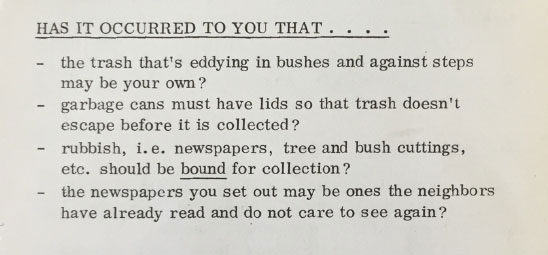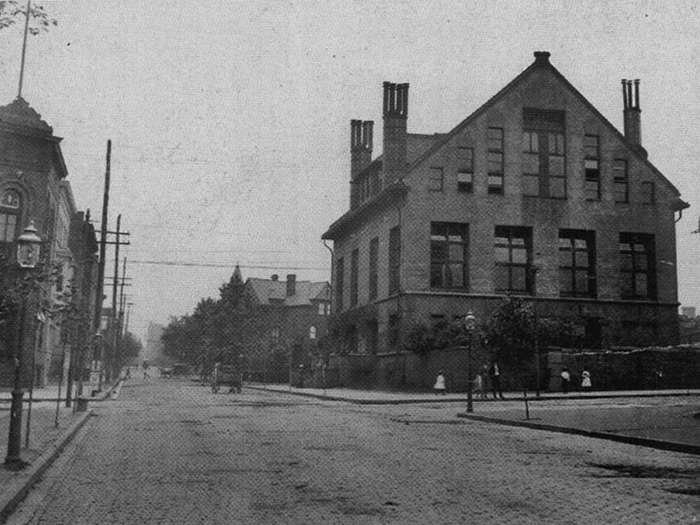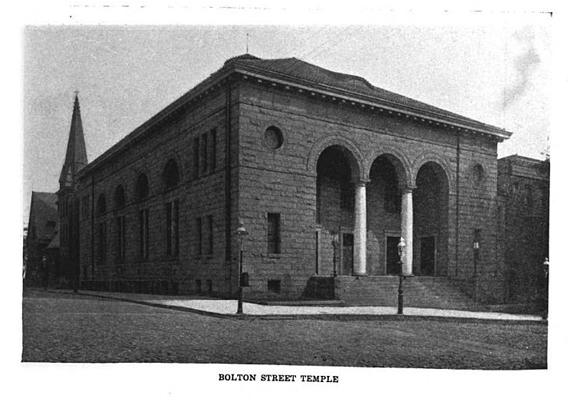Read the first part of the story here.
The impetus to begin publication may have been spurred by the neighborhood’s official designation as a Baltimore historic district in 1969, and its inclusion as the first Baltimore area on the National Register of Historic Places (NRHP), in 1971. The Bulletin became a key way to spread word of these designations and to explain their significance to residents and non-residents alike.

In the third issue of the Bulletin, keeper of the NRHP William Murtagh described the list, established by federal legislation in 1966, as “a way to combat visual and cultural pollution, which can be just as depressing as air and water pollution.” Throughout the first year of the Bulletin’s existence, Verkerke consistently emphasized beautification, cleanliness, and appreciation of the neighborhood’s historic significance.
The “Neighbors in the News” column, a feature continuing to the present day, highlighted the accomplishments of neighborhood residents. In the first year of the newsletter’s publication, Bolton Hill residents (and their homes) were featured in local and national publications including the Baltimore Sun, Forbes, Better Homes and Gardens, and Esquire.
The Bulletin also kept residents abreast of the latest news regarding the development of the various parcels of vacant land surrounding and throughout the neighborhood, including:
- Lot 19 and Lot 1 of the Madison Park South Redevelopment Plan at Mt. Royal and south of North Ave., resulting in the construction of the Bolton North high rise and the addition to Mt. Royal Elementary
- the parcel that became the Linden Green condominium development
- the site of Fitzgerald Park at the corner of Bolton and Wilson, former site of the Cornerstone Baptist Church (originally the Har Sinai Congregation synagogue), which had been destroyed by fire just three years earlier in 1969
- the demolition of Deutsches Haus, which had housed a group of German singing societies since the 1930s and was also the former home of the Bryn Mawr School. (The Joseph Meyerhoff Symphony Hall was built on the site.)
- the purchasing and renovation of monumental rowhouses on the 1200 and 1300 blocks of Eutaw St., once home to prominent Baltimore citizens including Daniel Coit Gilman, Sidney Lanier, and Woodrow Wilson
Most of all, however, the Bulletin advocated for membership in MRIA, touted its accomplishments, and publicized its activities. “You have a super Board, who seek, strive, bend over backward, turn handsprings, to do their best for you,” Verkerke wrote in February 1973.
Within a year, the Bulletin declared that it was instrumental in bringing 100 new members to MRIA. It also became a tool to recruit new residents. A special issue distributed at the long-running annual City Fair (1970-1991), guest-edited by Frank Shivers (1400 block Bolton St.), featured a paean to Baltimore written by neighborhood literary lion Gerald Johnson (1300 block Bolton St.) and extolled the neighborhood’s beautiful architecture, plentiful amenities, and proximity both to cultural attractions in Baltimore and to lucrative jobs in D.C.
During its first year of publication, the Bulletin provides a poignant and sometimes amusing reminder of bygone Baltimore life. When the tiny houses between Lafayette and Mosher were homes for Bolton Hill’s very own artists’ colony, the Rutter St. Art Festival was held in each May and was a major fundraiser for MRIA. The Bolton Dinner Theater, located in Sutton Place, offered shows ranging from the familiar (“Charlie Brown”) to the more adventurous (“Moose, Why Are There Walnuts in the Medicine Cabinet?”). The Doll Hospital, 102 W. North Ave., advertised “Dolls repaired and redressed”—by appointment only—while the Panos Brothers Greek deli on Preston St. reminded readers that it could provide all the necessary ingredients for the “spanakopita, dolmadakia yialandji, or tiropetis” you might be planning for dinner.

Everything in the Bulletin emphasized the benefits of city living, almost to a fault. One of the continuing features was the “Notable Quotables,” which focused on the joys of urban life and, whenever possible, denigrated the suburbs. In March 1973, for example, she quoted Margaret Mead, who wrote that “The first thing we have to get rid of is this horrible independent little misery called the suburban home.”
While reminding us of a bygone era, perusing these issues also reminds us how much has remained the same. MRIA still meets at 8 p.m. on the first Tuesday of every month. Block parties, though less prevalent than they used to be, still provide festive occasions for neighbors to gather together in the spring, summer, and fall. Trash, then as always, was a perennial problem: “Plastic cans and trash bags are not rat-proof and their use is illegal,” Verkerke tersely reminded residents in July 1972.

And what to do about man’s best friend, in one of the most dog-friendly but yard-starved areas of the city? This, it seems, was the crusade Editor Verkerke took on for herself. Nearly every issue included some mention of “the dog problem,” and Verkerke implored readers to “Curb Your Dog,” devoting stories, ads, and graphics to the cause.

The issues from the first year of the Bulletin provide a colorful look into a scrappy but always civilized group of people who chose to call Bolton Hill home, people who chose to live in the city despite the problems that the 1968 riots made starkly visible to the rest of the city and to the nation. In Maulsby’s view, the Bulletin helped show that it was possible to have a “densely developed urban community that wasn’t a slum.”
We’ll be featuring additional tidbits From Year One– and beyond– in future issues of the Bulletin during this 45th anniversary year. If you have ideas of things we might feature, or if you have back issues stashed somewhere that could be added to our online archive, please contact us at bhbeditor@gmail.com.



